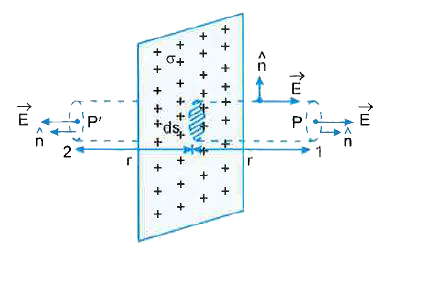Using Gauss' law porve that the electric field at a point due to a uniformaly charged infinite plane sheet is independent of the distance form it. How is the field directed if the sheet is
(i) positively charged, (ii) negatively charged.
For Gauss. theorem , see point number 47 under the heading "Chapter At A Glance" Consider an infinite thin plane sheet having a surface density σ. To find electric field at a point P situated at a normal distance r from the sheet , consider an imaginary cylinder of cross-section ara ds around point P and length 2r, passing through the sheet ,as the Gaussian surface.
From symmetry consideration , only side faces1 and 2 of cylinder contribute towards the flux because here
→Eandˆn parallel but the curved surface of cylinder does not contributed towards the flux because here →Eandˆn are mutually perpendicular.
∴ Total electric flux ϕ∈=2Eds
As per Gauss theorem total electric flux π∈=1∈0 (charge encloesd) =1∈0.(σds)
Comparing (i) and (ii) , we get
2Eds=σ∈0.ds⇒E=σ2∈0
Thus, the electric field at a point due to a uniformaly charged infinite plane sheet is independent of the distance from it .
Vectorially →E=σ2∈0ˆr
Thus for (i) positively charged sheet electric field →E is directed outwards and for (ii) negatively charged sheet the field is directed inwards.

Related Playlists
- BOOK - U-LIKE SERIESCHAPTER - ELECTRIC CHARGES AND FIELDS EXERCISE - LONG ANSWER QUESTIONS -II9videos
ELECTRIC CHARGES AND FIELDS
- BOOK - U-LIKE SERIESCHAPTER - ELECTRIC CHARGES AND FIELDS EXERCISE - SELF ASSESSMENT TEST (SECTION-A)5videos
ELECTRIC CHARGES AND FIELDS
- BOOK - U-LIKE SERIESCHAPTER - ELECTRIC CHARGES AND FIELDS EXERCISE - SHORT ANSWER QUESTIONS29videos
ELECTRIC CHARGES AND FIELDS
- BOOK - U-LIKE SERIESCHAPTER - DUAL NATURE OF RADIATION AND MATTEREXERCISE - SELF ASSESSMENT TEST SECTION-C (VERY SHORT ANSWER QUESTIONS)3videos
DUAL NATURE OF RADIATION AND MATTER
- BOOK - U-LIKE SERIESCHAPTER - ELECTROMAGNETIC WAVESEXERCISE - SELF ASSESSMENT TEST (SECTION C)1videos
ELECTROMAGNETIC WAVES
Similar Questions
(a) Define electric flux. Write its S.I. units.
(b) Using Gauss's law, prove that the electric field at a point due to a uniformly charged infinite plane sheet is independent of the distance from it.
(c ) How is the field directed if (i) the sheet is positively charged, (ii) negatively charged ?View SolutionState Gauss's theoram in electric field at a point due to a uniformaly charged infinite plane thin sheet.
View SolutionElectric field at a point near a uniformaly charged infinite plane sheet having surface density of charge σ is given as E= ________________
View SolutionThe expression for electric field intensity at a points outside uniformly charged thin plane sheet is (where, d is the distance of point from plane sheet)
View SolutionThe electric field at a point near an infinite thin sheet of a charged conductor is .
View SolutionUsing Gauss's law, derive an expression for the electric field intensity at any point near a uniformly charged thin wire of charge/length=λC/m.
View SolutionThe intensity of electric field at a point due to charged conductor of any shape or plane charged sheet is
View SolutionUsing Gauss’ law, derive an expression for the electric field at a point near an infinitely long straight uniformly charged wire.
View SolutionUsing Gauss’ law, derive an expression for the electric field at a point near an infinitely long straight uniformly charged wire.
View SolutionUsing Gauss's law derive an expression for the electric field at any point outside a uniformaly charged thin spherical shell of radius R and charge density σC/m2. Draw the field lines when the charges density of the sphere is (i) positive (ii) negative.
(b) A uniformly charged conducting sphere of 2.5 m in diameter has a surface charge density of 100μC/m2 Calculate the
(i) charge on the sphere (ii) total electric flux passing through the sphere.View Solution

